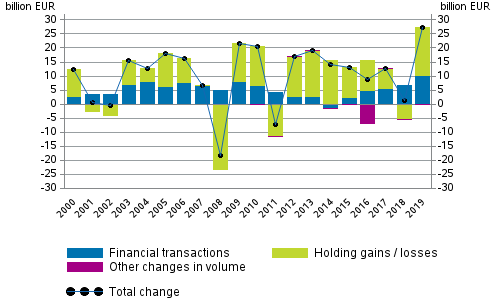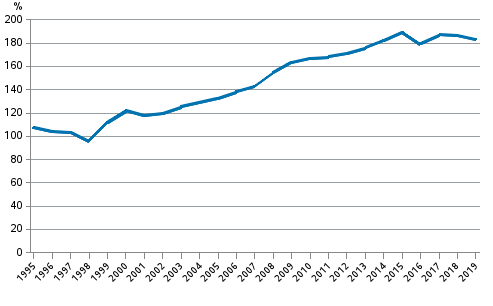1. Households’ financial assets grew
Households’ financial assets grew by EUR 27.2 billion during 2019 and rose to EUR 331.5 billion. Apart from the drop in the year before, a larger share of households' growth in financial assets has for a longer time come from holding gains than from new investments in financial assets. Holding gains are particularly affected by the favourable value development of share investments. In 2019, EUR 17.4 billion were generated in holding gains, while households’ net investments in financial assets amounted to EUR 9.9 billion.
The development of households’ net financial assets was also positive in 2019. Households' liabilities grew by EUR 10.1 billion. The difference between financial assets and liabilities was EUR 147.4 billion. Net financial assets grew by EUR 17.1 billion during the year.
Figure 1. Change in financial assets of households, EUR billion

Households’ net additional investments in financial assets grew compared with the previous year. Investments were made most to deposits. The transition from fixed-term deposits to cash deposits continued for the eighth successive year. Households withdrew EUR 0.5 billion of their assets from fixed-term deposits in 2019, at the same time as their transferable deposits increased by EUR 6.0 billion.
Households’ net investments in mutual fund shares amounted to EUR 1.8 billion and net investment flow in quoted shares to EUR 0.6 billion. The value of quoted shares held by households rose by EUR 6.0 billion. In addition, households accumulated holding gains from mutual fund shares and unquoted shares.
Overall, households’ financial assets amounted to EUR 331.5 billion at the end of 2019. Of these, EUR 97.3 billion were deposits, EUR 87.3 billion unquoted shares and equity, EUR 61.4 billion insurance and pension technical reserves, EUR 39.0 billion quoted shares, and EUR 28.1 billion mutual fund shares. The value of other financial assets held by households was EUR 18.4 billion. Households’ shares in housing corporations are not included in households’ financial assets in the financial accounts but they are part of other assets or non-financial assets.
The growth rate of households’ liabilities continued nearly unchanged. The amount of housing loans and other loan debts grew during 2019 by EUR 6.4 billion and reached EUR 156.7 billion at the end of the year. Households' indebtedness ratio, or the proportion of loan debts relative to their total disposable income in the four latest quarters, rose by 1.8 percentage points to 128.9 per cent. In this connection, loan debts are not compared to financial assets or total assets but to disposable income.
1.1. General government’s financial improved
General government's financial position improved in 2019. Net financial assets grew to EUR 152.0 billion, which is EUR 23.9 billion more than one year before. The growth in financial position is explained by an increase of EUR 21.6 billion in the net financial assets of employment pension schemes that belong to social security funds. Simultaneously, central government's net financial assets also grew, but local government's net financial assets decreased by EUR 1.9 billion. The net financial assets of other social security funds went up by EUR 0.2 billion. The following sections discuss in more detail the development of general government's net financial assets.
At the end of 2019, the level of central government's net financial assets stood at EUR -55.7 billion, which is EUR 4.0 billion more than at the end of 2018. The growth in net financial assets is based on changes in the holding of quoted shares and other equity.
Local government's net financial assets fell by EUR 1.9 billion during 2019. Net financial assets stood at EUR -6.7 billion at the end of 2019. The weakening of net financial assets was particularly caused by growth in long-term loan debts.
Employment pension schemes’ financial assets amounted to EUR 216.1 billion. At the same time, liabilities taken into account in financial accounts amounted to EUR 4.4 billion, so the amount of employment pension schemes’ net financial assets was EUR 211.7 billion. Net financial assets went up by EUR 21.6 billion from the previous year. The main reason for the growth in net financial assets was favourable market development. The market value of quoted shares rose by EUR 5.4 billion over the year.
The corresponding change in mutual fund shares was in total EUR 13.9 billion positive. More assets flowed to mutual fund shares on net to the tune of EUR 7.3 billion. Slightly over one-half of employment pension schemes’ financial assets are tied to fund shares. The net sales of quoted shares by employment pension companies amounted to EUR 2.3 billion. Assets flowed on net from deposits to the value of EUR 1.8 billion during 2019. The investment flow of debt security investments remained negative at EUR 4.3 billion but they generated holding gains of EUR 2.5 billion.
The net financial position of other social security funds in turn improved by EUR 0.2 billion from the previous year. At the end of 2019, the level of net financial assets was EUR 2.7 billion. The total amount of debt securities issued by other social security funds on the market decreased by EUR 0.6 billion and at the end of the year they no longer had liabilities in the form of debt securities.
1.2. Non-financial corporations’ debt financing grew moderately
Over the year, non-financial corporations' debt financing grew by slightly over EUR one billion. Debt financing refers to the total of loan debts and financing in the form of debt securities. Over the year, the stock of non-financial corporations' loan debts and debt securities grew from EUR 257.3 billion to EUR 258.4 billion. The rise was mainly due to an increase in the stock of long-term debt securities. Here, the non-financial corporations sector does not include financial and insurance corporations, housing companies or other housing corporations.
1.3. Domestic mutual funds back on growth track
The long growth of domestic mutual funds halted in 2018, but the break seems to have been short, as at the end of 2019, the value of mutual fund shares issued by them rose to a new record. Mutual funds grew by a total of EUR 18.6 billion from one year ago and stood at EUR 134.8 billion at the end of the year. Holding gains from mutual funds explain most of the annual change. The growth in mutual funds has been rapid and their value has nearly doubled from the situation at the end of 2012.
No major changes took place in the deposit bank sector in Finland in 2019. Loan receivables continued to grow. The value of loans granted by deposit banks was EUR 181.4 billion at the end of 2019. Good one-half of this are households' various loans and around one third the non-financial corporations sector's liabilities. At the end of 2019, the value of deposits in deposit banks was EUR 323.5 billion.
1.4. Liabilities of insurance corporations growing
Insurance corporations’ insurance and pension liabilities grew by EUR 5.7 billion to EUR 65.5 billion. The growth is explained by a EUR 4.7 billion increase in liabilities based on life insurance and annuity. Non-life insurance technical provisions grew by EUR 0.9 billion during 2019, while pension liabilities remained almost unchanged.
Insurance corporations’ financial assets rose from EUR 72.2 billion to EUR 77.6 billion in a year. The growth was particularly visible in mutual fund shares, the stock of which rose from EUR 38.2 billion to EUR 43.0 billion. Mutual fund shares accounted for 55 per cent of insurance corporations' financial assets. Insurance corporations held long-term debt securities to the tune of EUR 15.6 billion, which is EUR 1.2 billion less than one year ago. Deposit assets rose by EUR 1.4 billion to EUR 4.6 billion.
1.5. Foreign holdings in Finnish quoted shares fell slightly
Net investments to Finland by foreign bodies increased by EUR 25.4 billion in 2019. The most significant increases were seen in short-term and long-term debt securities, EUR 22.9 billion and in loans, EUR 11.2 billion. Foreign investors withdrew their holdings in deposits, quoted shares and mutual fund shares. At the end of the year, the value of foreign holdings in Finnish quoted shares was EUR 128.1 billion. The share of foreign holdings in the value of Finnish quoted shares fell by four percentage points year-on-year and was exactly 50 per cent at the end of 2019.
At the end of 2019, EUR 821.7 billion of the Finnish domestic sector's financial assets had been invested abroad. Of foreign investment instruments, particularly deposits, shares and mutual fund shares were favoured by domestic investors in 2019. At the end of the year, Finnish units owned EUR 62.8 billion worth of foreign quoted shares and EUR 127.6 billion worth of domestic quoted shares.
Finns owned foreign mutual fund shares to the value of EUR 154.1 billion and domestic ones to the value of EUR 107.7 billion. Net investments in foreign funds amounted EUR 9.4 billion. Together with EUR 16.9 billion holding gains, they raised the stock of foreign mutual fund shares owned by Finns from EUR 127.8 billion to EUR 154.1 billion.
1.6. Private sector debt decreased
The GDP share of private sector debt decreased by 2.7 percentage points to 183.7 per cent. Private sector debt comprises the loan debts and debts in the form of debt securities of non-financial corporations, households and non-profit institutions serving households. At the end of 2019, the private sector’s stock of liabilities was valued at EUR 442.0 billion in total.
Figure 2. Non-consolidated private sector debt as percentage of GDP

Source: Financial Accounts, Statistics Finland
Inquiries: Timo Ristimški 029 551 2324, Roope Rahikka 029 551 3338, rahoitus.tilinpito@stat.fi
Head of Department in charge: Mari Ylš-Jarkko
Updated 25.9.2020
Official Statistics of Finland (OSF):
Financial accounts [e-publication].
ISSN=1458-8145. 2019,
1. Households’ financial assets grew
. Helsinki: Statistics Finland [referred: 23.12.2025].
Access method: http://stat.fi/til/rtp/2019/rtp_2019_2020-09-25_kat_001_en.html

